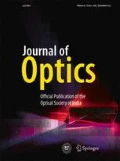Abstract
The photodetection classical theory is generally applied to communication systems working under optical frequencies. The recent development of non-classical theory uses photodetection statistics which require use of quantum theory. The growing interest in quantum detection techniques used in optics-based systems led to the study of quantum-based approaches in optics for improvement of various factors such as bit error rate and to examine the similarities and differences between the classical and quantum theory of optical communication. It has been observed that quantum detection technique gives more than 5 dB improvement in SNR and about 2.5 dB improvement in receiver sensitivity. This increased power budget can be used to increase the link length.













Similar content being viewed by others
References
E. Perspectives, Cisco Annual Internet Report (2018–2023) White Paper, Interplanetary Network Progress Report (2020), pp. 1–35. https://www.cisco.com/c/en/us/solutions/collateral/executive-perspectives/annual-internet-report/white-paper-c11-741490.pdf
V. Vilnrotter, C.-W. Lau, Quantum Detect. Channel Capacity Commun. Appl. 4635, 103–115 (2002). https://doi.org/10.1117/12.464084
V. Vilnrotter, C. Lau, Quantum detection theory for the free-space channel, The InterPlanetary Network Progress Report 42–146. April–June 2001, 1–34 (2001)
J.H. Shapiro, The quantum theory of optical communications. IEEE J. Sel. Top. Quantum Electron. 15(6), 1547–1569 (2009). https://doi.org/10.1109/JSTQE.2009.2024959
H. Wen, Y. Wang, An Evaluation Model of the Optical Quantum Communication Network (2009), pp. 50–53. https://doi.org/10.1109/YCICT.2009.5382435
B. Fröhlich, J.F. Dynes, M. Lucamarini, A.W. Sharpe, S.W.-B. Tam, Z. Yuan, A.J. Shields, Quantum secured gigabit passive optical networks, in Optical Fiber Communication Conference W4F(1) (2015). https://doi.org/10.1364/OFC.2015.W4F.1
R. Asif, Future Quantum-to-the-Home (qtth) All-Optical Networks (Invited Talk) (2018), pp. 41–46. https://doi.org/10.1109/ICAIT.2018.8686543
V.C. Usenko, M.G. Paris, Quantum communication with photon-number entangled states and realistic photodetection. Phys. Lett. A 374(11), 1342–1345 (2010). https://doi.org/10.1016/j.physleta.2010.01.016
C. Shukla, A. Pathak, Hierarchical quantum communication. Phys. Lett. A 377(19), 1337–1344 (2013). https://doi.org/10.1016/j.physleta.2013.04.010
F.-Y. Hong, S.-J. Xiong, W. Tang, Long-distance quantum communication with “polarization” maximally entangled states. Ann. Phys. 325(5), 1018–1025 (2010). https://doi.org/10.1016/j.aop.2010.02.001
H. Khanna, M. Aggarwal, S. Ahuja, Optimum distance and power allocation strategies for quantum-limited inter-relayed FSO communication system. AEU Int. J. Electron. Commun. 80, 10–18 (2017). https://doi.org/10.1016/j.aeue.2017.06.015
C. Kaernbach, Poisson signal-detection theory: link between threshold models and the Gaussian assumption. Percept. Psychophys. 50(5), 498–506 (1991)
A. Tafliovich, E.C. Hehner, Programming with quantum communication. Electron. Notes Theor. Comput. Sci. 253(3), 99–118 (2009). https://doi.org/10.1016/j.entcs.2009.10.008
Author information
Authors and Affiliations
Corresponding author
Additional information
Publisher's Note
Springer Nature remains neutral with regard to jurisdictional claims in published maps and institutional affiliations.
Rights and permissions
About this article
Cite this article
Kaur, N., Kumar, P. Improvement in error performance of optical communication system using quantum detection theory. J Opt 51, 505–513 (2022). https://doi.org/10.1007/s12596-021-00790-z
Received:
Accepted:
Published:
Issue Date:
DOI: https://doi.org/10.1007/s12596-021-00790-z




